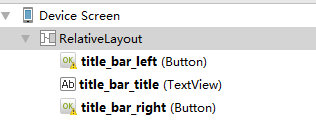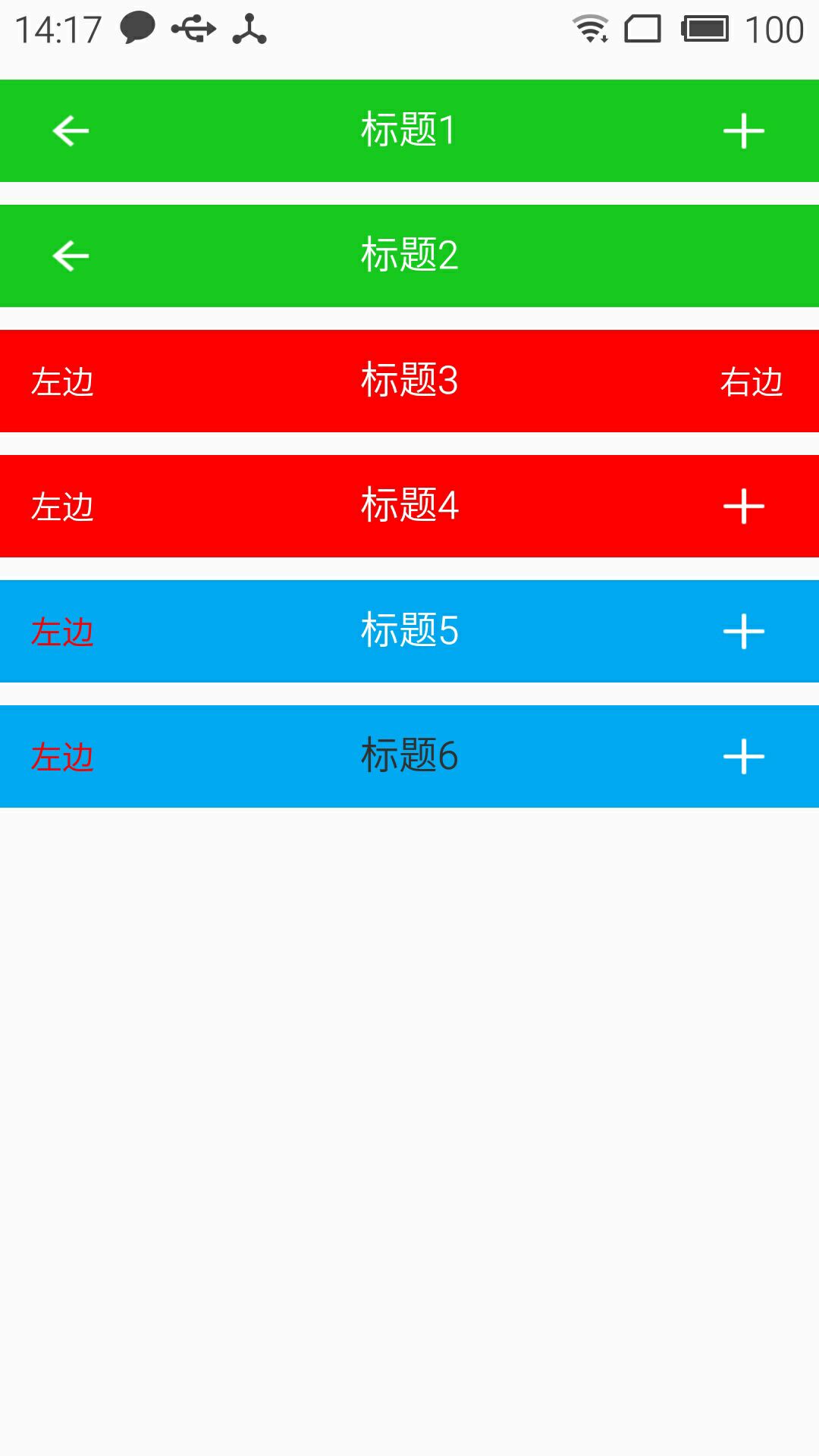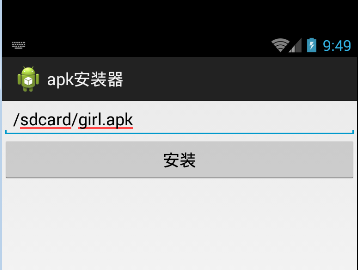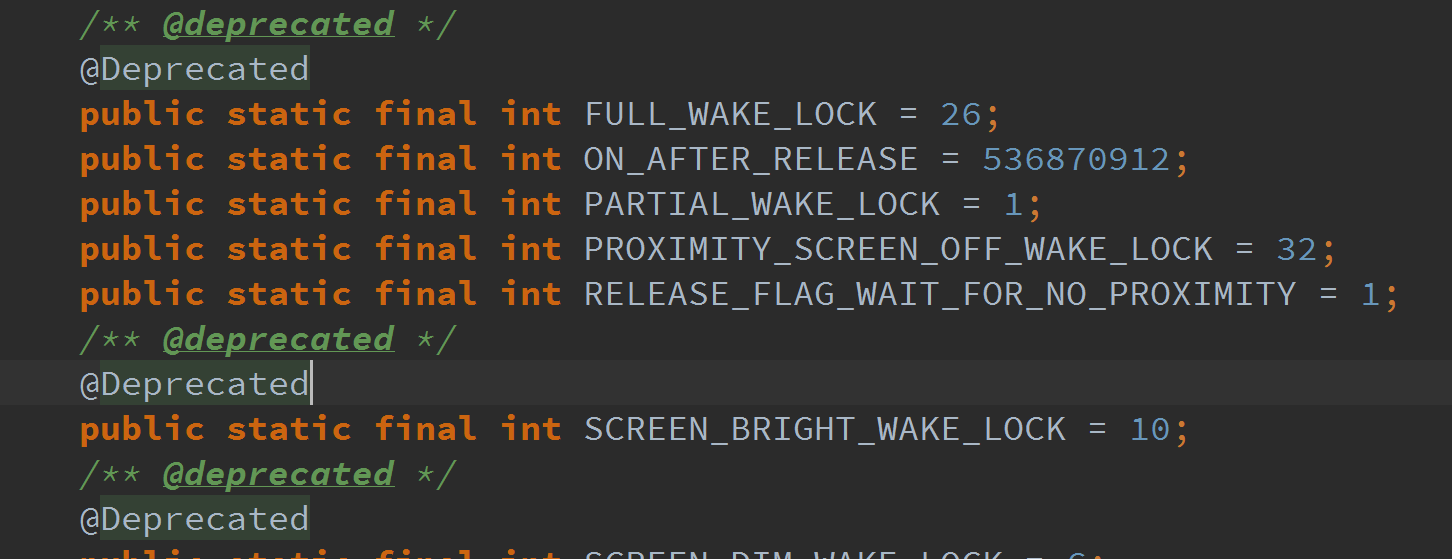編輯:關於android開發
前兩篇介紹了自定義控件的基礎原理Android自定義控件之基本原理(一)、自定義屬性Android自定義控件之自定義屬性(二)。今天重點介紹一下如何通過自定義組合控件來提高布局的復用,降低開發成本,以及維護成本。
我們在項目開發中經常會遇見很多相似或者相同的布局,比如APP的標題欄,我們從三種方式實現標題欄來對比自定義組件帶來的好處,畢竟好的東西還是以提高開發效率,降低開發成本為導向的。
<?xml version="1.0" encoding="utf-8"?>
<LinearLayout xmlns:android="http://schemas.android.com/apk/res/android"
xmlns:lee="http://schemas.android.com/apk/res-auto"
android:layout_width="match_parent"
android:layout_height="match_parent"
android:orientation="vertical">
<RelativeLayout
android:layout_width="match_parent"
android:background="@color/green"
android:layout_height="45dp">
<Button
android:id="@+id/title_bar_left"
android:layout_width="wrap_content"
android:layout_height="wrap_content"
android:layout_alignParentLeft="true"
android:layout_centerVertical="true"
android:layout_marginLeft="5dp"
android:background="@mipmap/titlebar_back_icon"
android:minHeight="45dp"
android:minWidth="45dp"
android:textSize="14sp" />
<TextView
android:id="@+id/title_bar_title"
android:layout_width="wrap_content"
android:layout_height="wrap_content"
android:layout_centerInParent="true"
android:text="登錄"
android:singleLine="true"
android:textSize="17sp" />
<Button
android:id="@+id/title_bar_right"
android:layout_width="wrap_content"
android:layout_height="wrap_content"
android:layout_alignParentRight="true"
android:layout_centerVertical="true"
android:layout_marginRight="7dp"
android:text="提交"
android:textColor="@android:color/white"
android:background="@null"
android:minHeight="45dp"
android:minWidth="45dp"
android:textSize="14sp" />
</RelativeLayout>
</LinearLayout>
這種方式沒有任何布局復用的概念,同時也讓當前的布局變得臃腫難以維護,開發效率低下,而且這個還需要要求每個開發人員必須細心否則有可能會做出參差不齊的標題欄,所以這種方式是最不推薦使用的。
首先定義標題欄布局
<RelativeLayout
android:layout_width="match_parent"
android:background="@color/green"
android:layout_height="45dp">
<Button
android:id="@+id/title_bar_left"
android:layout_width="wrap_content"
android:layout_height="wrap_content"
android:layout_alignParentLeft="true"
android:layout_centerVertical="true"
android:layout_marginLeft="5dp"
android:minHeight="45dp"
android:minWidth="45dp"
android:textSize="14sp" />
<TextView
android:id="@+id/title_bar_title"
android:layout_width="wrap_content"
android:layout_height="wrap_content"
android:layout_centerInParent="true"
android:singleLine="true"
android:textSize="17sp" />
<Button
android:id="@+id/title_bar_right"
android:layout_width="wrap_content"
android:layout_height="wrap_content"
android:layout_alignParentRight="true"
android:layout_centerVertical="true"
android:layout_marginRight="7dp"
android:background="@null"
android:minHeight="45dp"
android:minWidth="45dp"
android:textSize="14sp" />
</RelativeLayout>
然後在需要的地方通過include標簽實現引用
<LinearLayout xmlns:android="http://schemas.android.com/apk/res/android"
xmlns:lee="http://schemas.android.com/apk/res-auto"
android:layout_width="match_parent"
android:layout_height="match_parent"
android:orientation="vertical">
<include layout="@layout/view_title_bar" />
</LinearLayout>
通過上面的布局代碼,我們可以使用上面這種方式確實實現了布局的復用,而且也避免了開發人員開發出參差不齊標題欄的問題,但是同時也引入了新的問題,比如更加降低了開發效率,加大了開發成本,問題就在我們該如何為每個布局文件定義標題欄?只有通過代碼的方式來設置標題問題,左右按鈕等其他的屬性,導致布局屬性和Activity代碼耦合性比較高,所以這種方式也不是推薦的方式。
這裡先不具體介紹如何實現一個自定義組合控件,這裡先介紹一下自定義組合控件帶來的好處。
<merge xmlns:android="http://schemas.android.com/apk/res/android">
<Button
android:id="@+id/title_bar_left"
android:layout_width="wrap_content"
android:layout_height="wrap_content"
android:layout_alignParentLeft="true"
android:layout_centerVertical="true"
android:layout_marginLeft="5dp"
android:background="@null"
android:minHeight="45dp"
android:minWidth="45dp"
android:textSize="14sp" />
<TextView
android:id="@+id/title_bar_title"
android:layout_width="wrap_content"
android:layout_height="wrap_content"
android:layout_centerInParent="true"
android:singleLine="true"
android:textSize="17sp" />
<Button
android:id="@+id/title_bar_right"
android:layout_width="wrap_content"
android:layout_height="wrap_content"
android:layout_alignParentRight="true"
android:layout_centerVertical="true"
android:layout_marginRight="7dp"
android:background="@null"
android:minHeight="45dp"
android:minWidth="45dp"
android:textSize="14sp" />
</merge>
注意:這裡為何要使用merge標簽,自定義組合控件時會繼承RelativeLayout、LinearLayout等控件,這樣導致布局的層級無形中增加了一層,如下是對比:
未使用merge標簽

使用merge標簽

比如標題文字、標題欄左邊按鈕圖標等。
<declare-styleable name="CustomTitleBar">
<attr name="title_background_color" format="reference|integer" />
<attr name="left_button_visible" format="boolean" />
<attr name="right_button_visible" format="boolean" />
<attr name="title_text" format="string" />
<attr name="title_text_color" format="color" />
<attr name="title_text_drawable" format="reference|integer" />
<attr name="right_button_text" format="string" />
<attr name="right_button_text_color" format="color" />
<attr name="right_button_drawable" format="reference|integer" />
<attr name="left_button_text" format="string" />
<attr name="left_button_text_color" format="color" />
<attr name="left_button_drawable" format="reference|integer" />
</declare-styleable>
public class CustomTitleBar extends RelativeLayout {
private Button titleBarLeftBtn;
private Button titleBarRightBtn;
private TextView titleBarTitle;
public CustomTitleBar(Context context, AttributeSet attrs) {
super(context, attrs);
LayoutInflater.from(context).inflate(R.layout.custom_title_bar, this, true);
titleBarLeftBtn = (Button) findViewById(R.id.title_bar_left);
titleBarRightBtn = (Button) findViewById(R.id.title_bar_right);
titleBarTitle = (TextView) findViewById(R.id.title_bar_title);
TypedArray attributes = context.obtainStyledAttributes(attrs, R.styleable.CustomTitleBar);
if (attributes != null) {
//處理titleBar背景色
int titleBarBackGround = attributes.getResourceId(R.styleable.CustomTitleBar_title_background_color, Color.GREEN);
setBackgroundResource(titleBarBackGround);
//先處理左邊按鈕
//獲取是否要顯示左邊按鈕
boolean leftButtonVisible = attributes.getBoolean(R.styleable.CustomTitleBar_left_button_visible, true);
if (leftButtonVisible) {
titleBarLeftBtn.setVisibility(View.VISIBLE);
} else {
titleBarLeftBtn.setVisibility(View.INVISIBLE);
}
//設置左邊按鈕的文字
String leftButtonText = attributes.getString(R.styleable.CustomTitleBar_left_button_text);
if (!TextUtils.isEmpty(leftButtonText)) {
titleBarLeftBtn.setText(leftButtonText);
//設置左邊按鈕文字顏色
int leftButtonTextColor = attributes.getColor(R.styleable.CustomTitleBar_left_button_text_color, Color.WHITE);
titleBarLeftBtn.setTextColor(leftButtonTextColor);
} else {
//設置左邊圖片icon 這裡是二選一 要麼只能是文字 要麼只能是圖片
int leftButtonDrawable = attributes.getResourceId(R.styleable.CustomTitleBar_left_button_drawable, R.mipmap.titlebar_back_icon);
if (leftButtonDrawable != -1) {
titleBarLeftBtn.setBackgroundResource(leftButtonDrawable);
}
}
//處理標題
//先獲取標題是否要顯示圖片icon
int titleTextDrawable = attributes.getResourceId(R.styleable.CustomTitleBar_title_text_drawable, -1);
if (titleTextDrawable != -1) {
titleBarTitle.setBackgroundResource(titleTextDrawable);
} else {
//如果不是圖片標題 則獲取文字標題
String titleText = attributes.getString(R.styleable.CustomTitleBar_title_text);
if (!TextUtils.isEmpty(titleText)) {
titleBarTitle.setText(titleText);
}
//獲取標題顯示顏色
int titleTextColor = attributes.getColor(R.styleable.CustomTitleBar_title_text_color, Color.WHITE);
titleBarTitle.setTextColor(titleTextColor);
}
//先處理右邊按鈕
//獲取是否要顯示右邊按鈕
boolean rightButtonVisible = attributes.getBoolean(R.styleable.CustomTitleBar_right_button_visible, true);
if (rightButtonVisible) {
titleBarRightBtn.setVisibility(View.VISIBLE);
} else {
titleBarRightBtn.setVisibility(View.INVISIBLE);
}
//設置右邊按鈕的文字
String rightButtonText = attributes.getString(R.styleable.CustomTitleBar_right_button_text);
if (!TextUtils.isEmpty(rightButtonText)) {
titleBarRightBtn.setText(rightButtonText);
//設置右邊按鈕文字顏色
int rightButtonTextColor = attributes.getColor(R.styleable.CustomTitleBar_right_button_text_color, Color.WHITE);
titleBarRightBtn.setTextColor(rightButtonTextColor);
} else {
//設置右邊圖片icon 這裡是二選一 要麼只能是文字 要麼只能是圖片
int rightButtonDrawable = attributes.getResourceId(R.styleable.CustomTitleBar_right_button_drawable, -1);
if (rightButtonDrawable != -1) {
titleBarRightBtn.setBackgroundResource(rightButtonDrawable);
}
}
attributes.recycle();
}
}
public void setTitleClickListener(OnClickListener onClickListener) {
if (onClickListener != null) {
titleBarLeftBtn.setOnClickListener(onClickListener);
titleBarRightBtn.setOnClickListener(onClickListener);
}
}
public Button getTitleBarLeftBtn() {
return titleBarLeftBtn;
}
public Button getTitleBarRightBtn() {
return titleBarRightBtn;
}
public TextView getTitleBarTitle() {
return titleBarTitle;
}
}
關於如何使用自定義屬性這裡就不再說明了,為了更加直觀的查看效果,我這裡在一個布局文件中實現不同要求的標題欄
<?xml version="1.0" encoding="utf-8"?>
<LinearLayout xmlns:android="http://schemas.android.com/apk/res/android"
xmlns:lee="http://schemas.android.com/apk/res-auto"
android:layout_width="match_parent"
android:layout_height="match_parent"
android:orientation="vertical">
<com.whoislcj.views.CustomTitleBar
android:layout_width="match_parent"
android:layout_height="45dp"
android:layout_marginTop="10dp"
lee:right_button_drawable="@mipmap/titlebar_add_icon"
lee:title_background_color="@color/green"
lee:title_text="標題1" />
<com.whoislcj.views.CustomTitleBar
android:layout_width="match_parent"
android:layout_height="45dp"
android:layout_marginTop="10dp"
lee:right_button_visible="false"
lee:title_background_color="@color/green"
lee:title_text="標題2" />
<com.whoislcj.views.CustomTitleBar
android:layout_width="match_parent"
android:layout_height="45dp"
android:layout_marginTop="10dp"
lee:left_button_text="左邊"
lee:right_button_text="右邊"
lee:title_background_color="@color/red"
lee:title_text="標題3" />
<com.whoislcj.views.CustomTitleBar
android:layout_width="match_parent"
android:layout_height="45dp"
android:layout_marginTop="10dp"
lee:left_button_text="左邊"
lee:right_button_drawable="@mipmap/titlebar_add_icon"
lee:title_background_color="@color/red"
lee:title_text="標題4" />
<com.whoislcj.views.CustomTitleBar
android:layout_width="match_parent"
android:layout_height="45dp"
android:layout_marginTop="10dp"
lee:left_button_text="左邊"
lee:left_button_text_color="@color/red"
lee:right_button_drawable="@mipmap/titlebar_add_icon"
lee:title_background_color="@color/blue"
lee:title_text="標題5" />
<com.whoislcj.views.CustomTitleBar
android:layout_width="match_parent"
android:layout_height="45dp"
android:layout_marginTop="10dp"
lee:left_button_text="左邊"
lee:left_button_text_color="@color/red"
lee:right_button_drawable="@mipmap/titlebar_add_icon"
lee:title_background_color="@color/blue"
lee:title_text="標題6"
lee:title_text_color="@color/black" />
</LinearLayout>
顯示效果

通過本篇文章我們得知,通過自定義組合控件確實能夠提高開發效率,降低維護成本,但是也需要UI設計風格保持高度一致,不然的話只能呵呵哒了!所以想要做好一個app需要一個有共識的團隊才行。本篇介紹到此為止,下一篇要更新什麼我還沒有想好!有可能是自定義控件的事件回調,也有可能自定義ViewGroup實現流式布局。
 Volley 源碼解析,volley源碼解析
Volley 源碼解析,volley源碼解析
Volley 源碼解析,volley源碼解析1. 功能介紹 1.1. Volley Volley 是 Google 推出的 Android 異步網絡請求框架和圖片加載框架
 android: ListView歷次優化,androidlistview
android: ListView歷次優化,androidlistview
android: ListView歷次優化,androidlistview第一版: ListView一屏顯示多少對象其內部就創建多少View對象。滑動時退出的緩存對象
 Android APK的安裝,AndroidAPK安裝
Android APK的安裝,AndroidAPK安裝
Android APK的安裝,AndroidAPK安裝打開packages\apps\PackageInstaller下的清單文件 <?xml version=1
 android中保持屏幕常亮,android屏幕常亮
android中保持屏幕常亮,android屏幕常亮
android中保持屏幕常亮,android屏幕常亮關於android開發中保持屏幕常亮這個問題網上的很多文章都表示需要配合使用 PowerManager&nb